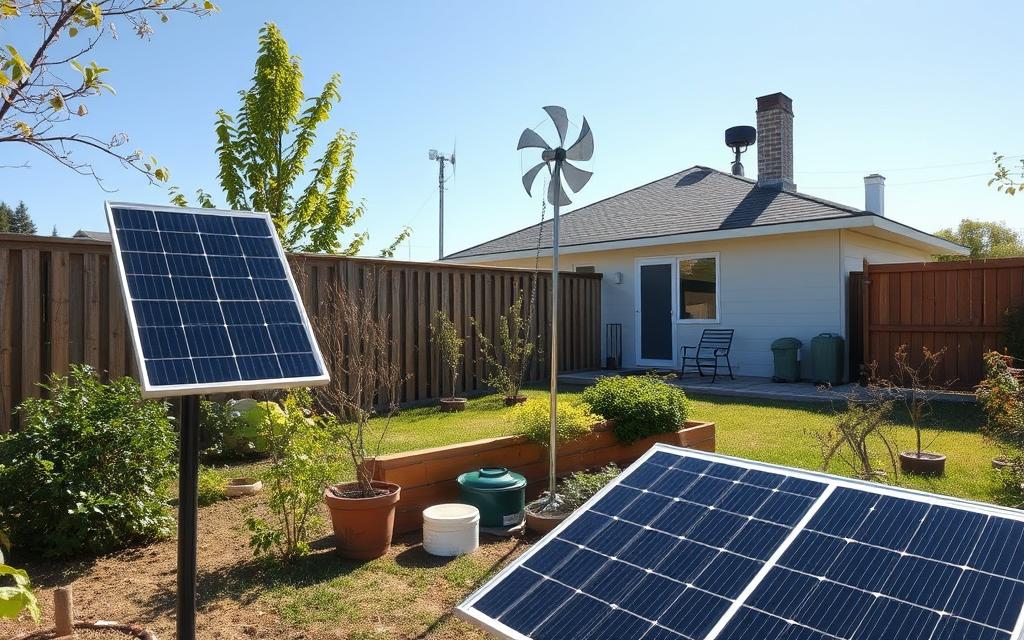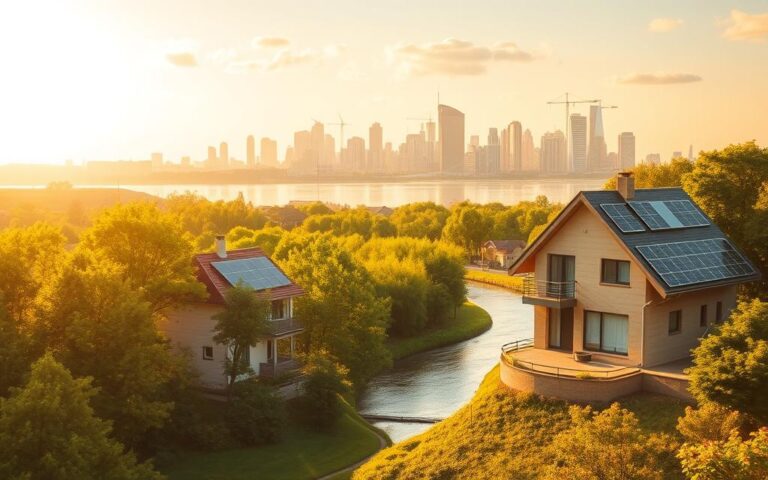
American homes can slash their carbon footprint by 80% with DIY renewable energy projects. These sustainable improvements are now a practical reality for U.S. homeowners. They’re no longer just an environmental dream.
Clean energy projects have become accessible home improvement strategies. They empower homeowners to manage their energy use and cut costs. These solutions also help protect the environment.
Affordable solar panels and wind turbines have made sustainable home upgrades easier. Energy storage systems are now more innovative too. Homeowners can use these to reduce electricity bills and help the planet.
This guide covers practical DIY renewable energy projects for your home. You’ll learn how to create an eco-friendly living space using clean energy tech. These solutions are cost-effective and good for the environment.
DIY renewable energy offers a path to energy independence. You can install solar panels, wind turbines, or harvest rainwater. These projects save money and reduce global carbon emissions.
Understanding the Basics of Home Renewable Energy Systems
Home renewable energy offers sustainable and cost-effective power solutions for homeowners. It’s a way to reduce carbon footprints and potentially lower electricity bills. Clean energy systems can transform how we power our homes.
Modern home renewable energy systems provide various clean power options. These technologies can be tailored to your specific residential environment. Understanding which option fits your needs is crucial.
Exploring Renewable Energy Sources
- Solar Photovoltaic Panels: Converts sunlight into electricity
- Wind Turbines: Generates power from wind movement
- Geothermal Systems: Utilizes underground heat sources
- Micro-Hydropower: Harnesses flowing water energy
Benefits of Residential Clean Energy
| Benefit Category | Specific Advantages |
|---|---|
| Financial | Reduced electricity bills, potential tax credits |
| Environmental | Lower carbon emissions, reduced fossil fuel dependency |
| Energy Independence | Less reliance on grid electricity, backup power options |
Initial Energy Assessment
A thorough energy assessment is key for successful home renewable energy implementation. This process evaluates your property’s unique features. It helps determine the best energy strategies for your home.
- Current energy consumption patterns
- Geographical location and climate conditions
- Available space for renewable energy installations
- Budget and long-term financial goals
Professional assessments offer detailed insights into effective renewable energy strategies. They consider your specific residential setting and needs. This guidance can help you make informed decisions about clean energy.
Essential Tools and Materials for DIY Renewable Energy
Proper preparation is key for DIY renewable energy projects. You’ll need the right home energy equipment and materials. Having these essentials ensures successful implementation of sustainable energy solutions.
Gather these fundamental DIY energy tools before starting your project:
- Multimeter for electrical testing
- Wire strippers and cutters
- Drill and drill bit set
- Safety equipment (gloves, goggles, hard hat)
- Voltage tester
- Measuring tape
High-quality materials greatly affect your project’s success. They impact efficiency and longevity. Consider these critical components:
| Material Category | Recommended Components | Estimated Cost Range |
|---|---|---|
| Solar Panel Materials | Photovoltaic cells, mounting brackets, silicon sealant | $200 – $500 |
| Wind Turbine Components | Blade materials, generator, tower hardware | $300 – $700 |
| Electrical Connection Supplies | Copper wiring, connectors, junction boxes | $100 – $250 |
Pro tip: Always purchase materials from reputable suppliers and ensure compatibility with your specific home energy equipment setup.
Investing in quality tools and materials is the foundation of successful DIY renewable energy projects.
Look for home energy equipment from various sources. Check local suppliers, online marketplaces, and specialized renewable energy stores. Compare prices and read reviews carefully.
Verify product specifications before making a purchase. This helps you make smart choices for your project.
Solar Panel Installation Guide for Homeowners
DIY solar installation can transform your home’s energy profile and reduce electricity costs. Careful planning and precise execution are key to understanding home solar panels. This guide will help you navigate the process effectively.
Successful solar energy implementation starts with comprehensive calculation and strategic planning. Homeowners must assess their energy needs and roof characteristics before installation. This ensures optimal system performance and efficiency.
Calculating Solar Panel Requirements
Determining the right number of home solar panels involves several critical steps:
- Analyze monthly electricity consumption
- Evaluate available roof space
- Calculate peak sunlight hours in your region
- Consider panel efficiency ratings
Mounting Systems and Positioning
Panel placement greatly impacts energy generation. The ideal mounting system depends on your roof type and local climate. Choosing the right system ensures maximum energy capture and system longevity.
| Mounting Type | Pros | Cons |
|---|---|---|
| Fixed Roof Mount | Low cost, simple installation | Limited angle adjustment |
| Adjustable Tilt Mount | Enhanced energy capture | Higher installation complexity |
| Ground Mount | Maximum positioning flexibility | Requires additional land space |
Wiring and Connection Basics
Professional electrical expertise is crucial during the final connection phase. Safety should always be the primary consideration. Proper wiring ensures system efficiency and prevents potential hazards.
“Proper solar panel installation requires precision, patience, and professional guidance.” – Solar Energy Expert
DIY solar installation offers significant cost savings. However, consulting a certified electrician ensures system reliability and compliance with local regulations. This step is vital for a safe and effective installation.
Building a Small-Scale Wind Turbine System

Home wind energy is an exciting option for sustainable power. A DIY wind turbine can turn your property into a renewable energy generator. It reduces electricity costs and helps the environment.
Small-scale wind power needs careful planning. Understanding key components is crucial. Consider these essential elements before starting your project:
- Wind speed and local weather patterns
- Property layout and available space
- Local zoning regulations
- Estimated energy production
Building a home wind turbine involves several critical steps. You’ll need specific materials and tools for an effective system:
- Wind turbine blades
- Generator unit
- Tower or mounting structure
- Electrical wiring and connection components
- Battery storage system
Choosing the right location for your DIY wind turbine is vital. Look for areas with steady wind speeds of 7-10 miles per hour. Open spaces away from buildings and tall trees work best.
“Renewable energy starts at home, one wind turbine at a time.”
Maintaining your small-scale wind power system is crucial. Regular checks of blades, connections, and structure are important. This ensures efficient operation and longer lifespan of your home wind energy system.
DIY Solar Water Heater Construction
Solar thermal systems offer eco-friendly and cost-effective water heating. A DIY solar water heater can slash energy costs and reduce environmental impact. It’s a smart choice for homeowners seeking sustainable solutions.
Building a solar water heater requires careful planning and understanding. Key components must be selected carefully. An efficient system design is crucial for capturing and transferring solar energy effectively.
Material Selection and Cost Analysis
Choosing the right materials is crucial for a successful DIY solar water heater. Consider collector panels, storage tanks, piping, and mounting hardware carefully.
- Collector panels: Flat plate or evacuated tube designs
- Storage tank: Insulated, corrosion-resistant materials
- Piping: Copper or stainless steel for durability
- Mounting hardware: Stainless steel or aluminum brackets
Costs typically range from $1,500 to $3,500. The final price depends on system complexity and local installation requirements.
Installation Steps and Safety Measures
Installing a solar thermal system requires precision and safety awareness. Follow these steps for a successful installation:
- Assess roof structural integrity
- Ensure proper angle and sun exposure
- Install mounting brackets securely
- Connect collector panels to storage tank
- Implement backup heating connections
*Safety first: Always consult local building codes and consider professional guidance for complex installations.*
Maintenance Requirements
Regular upkeep ensures your solar water heater lasts longer and works efficiently. Here’s what you need to do:
- Annual collector panel cleaning
- Check fluid levels and antifreeze concentration
- Inspect mounting hardware for corrosion
- Test system pressure and circulation
A DIY solar water heater project offers sustainable, energy-efficient water heating. It’s a great way to reduce your carbon footprint and save money.
Creating a Rainwater Harvesting System
DIY rainwater harvesting is a smart way to save water. It turns your home into a water-saving powerhouse. You can use the collected rainwater for many things.
To make a good system, you need to plan carefully. This helps homeowners use less water and support the environment.
- Assess your property’s roof area and rainfall patterns
- Select appropriate collection and storage equipment
- Install proper filtration and treatment systems
- Understand local water conservation regulations
Key parts for DIY rainwater harvesting include:
- Gutters and downspouts for efficient water collection
- First-flush diverters to remove initial contaminated runoff
- High-quality storage tanks with appropriate capacity
- Filtration systems for different water usage needs
“Water conservation isn’t just about saving resources—it’s about creating sustainable solutions for our homes and communities.”
Your system can be used for many things. It can water gardens and supply non-drinking water for your home.
Smart design helps you save more water. It also reduces your need for city water supplies.
DIY Renewable Energy Storage Solutions
Home energy storage is vital for sustainable power systems. It helps maximize clean energy sources through efficient storage. DIY battery banks can change how homeowners manage their electricity.
Effective storage balances energy generation and use. Storing extra power from solar panels or wind turbines ensures constant electricity. This works even during low-production times.
Battery Bank Setup Strategies
Choosing the right battery is key for a DIY battery bank. Each type offers unique benefits:
- Lithium-ion batteries: High energy density and longer lifespan
- Lead-acid batteries: Cost-effective and reliable
- Gel cell batteries: Maintenance-free and spill-proof
Power Inverter Installation Essentials
Power inverters change stored DC energy into usable AC electricity. When picking an inverter, think about these factors:
| Inverter Type | Power Capacity | Best Use |
|---|---|---|
| Pure Sine Wave | 1000-5000 watts | Sensitive electronics |
| Modified Sine Wave | 500-3000 watts | Basic appliances |
System Integration Tips
Good renewable energy integration needs careful planning. Use monitoring systems to track energy production, storage, and use. Keep battery banks and inverters in top shape.
“A well-designed home energy storage system can reduce electricity costs by up to 70%.” – Renewable Energy Research Institute
DIY fans can build great home energy storage systems. They need to understand tech requirements and choose the right parts. Good integration techniques are also important.
Conclusion: Embracing a Sustainable Future with DIY Renewable Energy
DIY renewable energy projects can transform your home into an energy-efficient sanctuary. These initiatives reduce carbon footprints and create a resilient home energy system. Every solar panel or wind turbine you install contributes to sustainable living.
Renewable energy offers benefits beyond individual savings. Homeowners can enjoy reduced monthly utility bills and increased property value. These investments provide long-term economic returns while supporting environmental conservation.
Starting small is crucial for success in renewable energy. Begin with manageable projects like solar water heaters or compact wind turbines. Gradually expand your home’s clean energy capabilities over time.
The U.S. Department of Energy and local renewable energy associations offer valuable resources. They provide guidance and support for homeowners starting this transformative journey.
Your energy-efficient home can inspire neighbors and drive wider adoption of sustainable technologies. Individual actions contribute to a global movement towards cleaner energy consumption. Together, we can create a more sustainable future.
FAQ
What are the most common types of renewable energy for home use?
Solar power, wind energy, hydropower, and geothermal systems are popular for homes. Solar panels and small wind turbines are common DIY projects. They’re easy to install and can save a lot of energy.
How much does it cost to set up a DIY renewable energy system?
Costs vary based on project type and size. A small solar panel system might cost $5,000 to $15,000. A full home renewable setup could range from $20,000 to $50,000.
DIY methods can greatly reduce expenses. Many homeowners recover their investment through energy savings and tax incentives.
Do I need special permits for installing renewable energy systems?
Most areas require permits for renewable energy installations. Check with your local building department, HOA, and utility company before starting. Some places have rules about system size, placement, and grid connection.
Can I completely go off-grid with a home renewable energy system?
Going off-grid is possible, but most homeowners choose a grid-tied system. This allows them to use renewable energy while staying connected to traditional power. It provides backup power and the chance to sell excess energy back.
What maintenance is required for renewable energy systems?
Maintenance needs differ by system type. Solar panels need yearly cleaning and occasional checks. Wind turbines require more frequent inspections of moving parts. Battery systems need regular upkeep for best performance.
Homeowners can do basic maintenance, but professional checks are advised every few years.
How much energy can I generate with a home renewable system?
Energy production depends on location, system size, and environment. A typical home solar system might generate 350-850 kilowatt-hours monthly. A small wind turbine could produce 100-300 kilowatt-hours per month.
Your output will vary based on your location, system design, and local climate.
Are there tax credits or incentives for renewable energy projects?
Yes, the federal government and many states offer renewable energy incentives. The federal solar tax credit gives a large percentage of system costs back. Many states provide extra rebates, grants, and tax breaks for these projects.
How long do renewable energy systems typically last?
Renewable energy systems have long lifespans. Solar panels usually last 25-30 years. Wind turbines can work well for 20-25 years. Battery storage systems often last 10-15 years.
Regular upkeep can help these systems last even longer.




